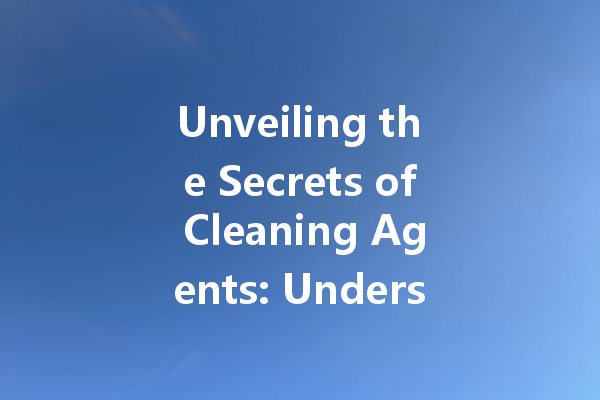Cleaning agents are an essential part of our everyday lives, whether at home, in the workplace, or in specialized environments like hospitals and industrial settings. They come in various forms and serve numerous functions, but with so many options available, it’s important to understand what these agents are, their types, and how to use them safely. In this article, we’ll explore the world of cleaning agents, shedding light on their common types and safe handling practices.
What Are Cleaning Agents?
Cleaning agents, also known as detergents or cleaners, are substances designed to facilitate the removal of dirt, stains, and unwanted materials from surfaces. They can be chemical or biochemical formulations and are crucial in achieving cleanliness in our surroundings. Cleaning agents work by altering the surface properties of soils and contaminants, making them easier to remove.
Common Types of Cleaning Agents
Alkaline cleaners are typically used for heavy-duty cleaning tasks. They are effective against grease, oils, and food residues, making them ideal for kitchen and industrial applications. Common ingredients in alkaline cleaners include sodium hydroxide and potassium hydroxide, which help to break down tough stains.
Acidic cleaners are most effective for removing mineral deposits, rust stains, and soap scum. These cleaning agents generally contain acids such as citric acid or hydrochloric acid. While effective, these cleaners should be used with caution, especially on surfaces that may be sensitive to acidic solutions.
Neutral cleaners have a pH balanced formula, making them versatile for various surfaces without causing damage. These agents are ideal for daily cleaning tasks and are often used in homes and offices due to their gentle cleaning properties.
Surfactants are compounds that reduce the surface tension of water, allowing it to spread and penetrate surfaces more easily. These are commonly found in various household cleaners, such as laundry detergents and dishwashing liquids. They help lift and remove dirt and grease effectively.
Disinfectants are specialized cleaning agents designed to kill bacteria and viruses on surfaces. With increasing awareness of hygiene, especially during recent global health crises, disinfectants have gained popularity. Common active ingredients include alcohol, bleach, or quaternary ammonium compounds.
Understanding the Role of Cleaning Agents
The Science Behind Cleaning
Cleaning agents work through various mechanisms, including emulsification, solubilization, and chemical reactions. Emulsification involves breaking down grease and dirt into smaller droplets, allowing for easier wiping or rinsing away. Solubilization helps dissolve contaminants in the cleaning solution, while chemical reactions can neutralize or break down certain substances.
Safe Usage and Handling
While cleaning agents are effective, it’s crucial to use them safely. Always follow the manufacturer’s instructions for use and dilution. Protective gear, such as gloves and masks, should be worn when handling strong chemicals to prevent skin irritation and respiratory issues. It’s also essential to ensure proper ventilation when using potent cleaning agents to minimize inhalation risks.
Environmental Considerations
The Impact of Cleaning Agents
With growing concern for the environment, many consumers are now considering the ecological impact of cleaning agents. Traditional chemical cleaners can contribute to water pollution and harmful effects on ecosystems. As a result, biodegradable and non-toxic cleaning options have started to surface in the market.
Green Cleaning Agents
Green cleaning agents are formulated without harmful chemicals, often using natural ingredients like vinegar, baking soda, and essential oils. These eco-friendly options effectively clean without leaving behind harmful residues, making them a popular choice for health-conscious consumers.
Conclusion
Understanding cleaning agents, their types, and proper usage can significantly enhance our cleaning routines. By selecting the right products and using them safely, we can maintain clean spaces while being mindful of our health and the environment. Whether you prefer traditional cleaners or eco-friendly options, knowledge is key to making informed choices and achieving a clean and safe environment.

